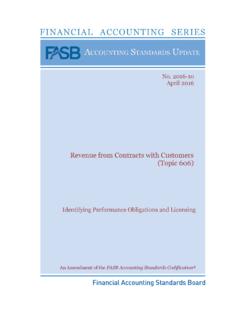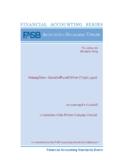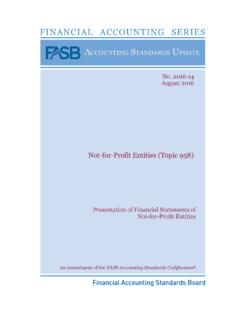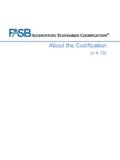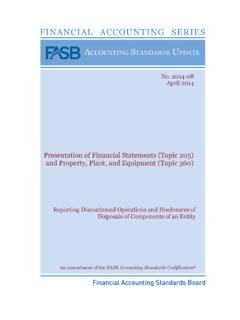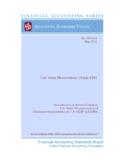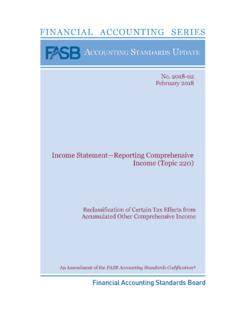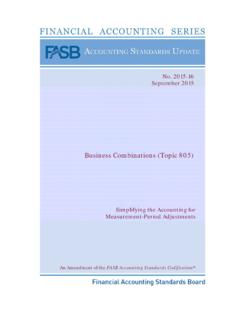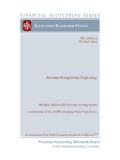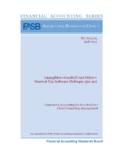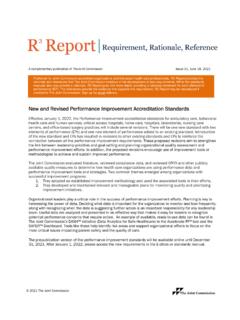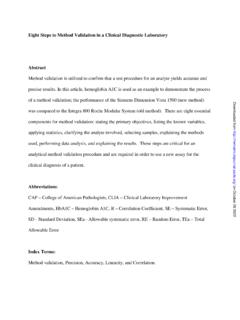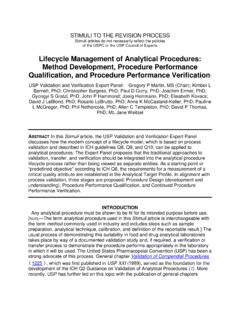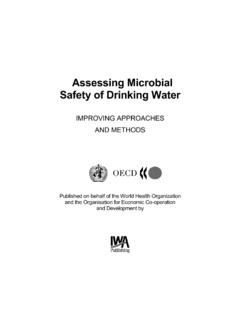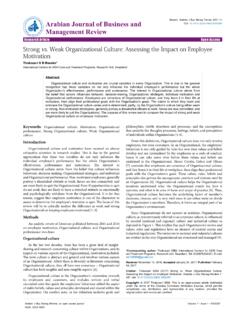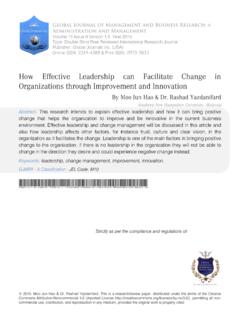Transcription of Revenue from Contracts with Customers (Topic 606)
1 Revenue from Contracts with Customers (Topic 606) No. 2016-12 May 2016 Narrow-Scope Improvements and Practical Expedients An Amendment of the FASB Accounting Standards Codification The FASB Accounting Standards Codification is the source of authoritative generally accepted accounting principles (GAAP) recognized by the FASB to be applied by nongovernmental entities. An Accounting Standards Update is not authoritative; rather, it is a document that communicates how the Accounting Standards Codification is being amended. It also provides other information to help a user of GAAP understand how and why GAAP is changing and when the changes will be effective. For additional copies of this Accounting Standards Update and information on applicable prices and discount rates contact: Order Department Financial Accounting Standards Board 401 Merritt 7 PO Box 5116 Norwalk, CT 06856-5116 Please ask for our Product Code No.
2 ASU2016-12. FINANCIAL ACCOUNTING SERIES (ISSN 0885-9051) is published monthly with the exception of January and October by the Financial Accounting Foundation, 401 Merritt 7, PO Box 5116, Norwalk, CT 06856-5116. Periodicals postage paid at Norwalk, CT and at additional mailing offices. The full subscription rate is $255 per year. POSTMASTER: Send address changes to Financial Accounting Standards Board, 401 Merritt 7, PO Box 5116, Norwalk, CT 06856-5116. | No. 436 Copyright 2016 by Financial Accounting Foundation. All rights reserved. Content copyrighted by Financial Accounting Foundation may not be reproduced, stored in a retrieval system, or transmitted, in any form or by any means, electronic, mechanical, photocopying, recording, or otherwise, without the prior written permission of the Financial Accounting Foundation. Financial Accounting Foundation claims no copyright in any portion hereof that constitutes a work of the United States Government.
3 An Amendment of the FASB Accounting Standards Codification No. 2016-12 May 2016 Revenue from Contracts with Customers (Topic 606) Narrow-Scope Improvements and Practical Expedients Accounting Standards UpdateFinancial Accounting Standards Board Accounting Standards Update 2016-12 Revenue from Contracts with Customers (Topic 606) Narrow-Scope Improvements and Practical Expedients May 2016 CONTENTS Page Numbers Summary .. 1 7 Amendments to the FASB Accounting Standards Codification .. 9 28 Background Information and Basis for Conclusions .. 29 46 Appendix: Comparison of Topic 606 and IFRS 82 Amendments to the XBRL Taxonomy .. 83 1 Summary Why Is the FASB Issuing This Accounting Standards Update (Update)? On May 28, 2014, the FASB and the International Accounting Standards Board (IASB) issued a converged standard on recognition of Revenue from Contracts with Customers . In June 2014, the FASB and the IASB (collectively, the Boards) announced the formation of the FASB-IASB Joint Transition Resource Group for Revenue Recognition (TRG).
4 One of the objectives of the TRG is to inform the Boards about potential implementation issues that could arise when organizations implement the new Revenue guidance. The TRG also assists stakeholders in understanding specific aspects of the new Revenue guidance. The TRG does not issue authoritative guidance. Instead, the Boards evaluate the feedback received from the TRG and other stakeholders to determine what action, if any, is necessary for each potential implementation issue. To address certain issues identified by the TRG in the guidance on assessing collectibility, presentation of sales taxes, noncash consideration, and completed Contracts and contract modifications at transition, the Board decided to add a project to its technical agenda to improve Topic 606, Revenue from Contracts with Customers , by reducing: 1. The potential for diversity in practice at initial application 2. The cost and complexity of applying Topic 606 both at transition and on an ongoing basis.
5 Who Is Affected by the Amendments in This Update? The amendments in this Update affect entities with transactions included within the scope of Topic 606. The scope of that Topic includes entities that enter into Contracts with Customers to transfer goods or services (that are an output of the entity s ordinary activities) in exchange for consideration. The amendments to the recognition and measurement provisions of Topic 606 also affect entities with transactions included within the scope of Topic 610, Other Income. What Are the Main Provisions and How Are They an Improvement? The core principle of the guidance in Topic 606 is that an entity should recognize Revenue to depict the transfer of promised goods or services to Customers in an amount that reflects the consideration to which the entity expects to be entitled in 2 exchange for those goods or services. To achieve that core principle, an entity should apply the following steps: 1.
6 Identify the contract (s) with a customer . 2. Identify the performance obligations in the contract . 3. Determine the transaction price. 4. Allocate the transaction price to the performance obligations in the contract . 5. Recognize Revenue when (or as) the entity satisfies a performance obligation. The amendments in this Update do not change the core principle of the guidance in Topic 606. Rather, the amendments in this Update affect only the narrow aspects of Topic 606 noted in the table below. Area for Improvement Summary of Amendments assessing the Collectibility Criterion in Paragraph 606-10-25-1(e) and Accounting for Contracts That Do Not Meet the Criteria for Step 1 (Applying Paragraph 606-10-25-7) One criterion in Step 1 of the new Revenue model is that it is probable that an entity will collect the consideration to which it will be entitled in exchange for the goods or services that will be transferred to the customer .
7 Some TRG members and other stakeholders narrowly interpreted the guidance related to collectibility in a manner that would result in more Contracts than the Board intended not meeting the collectibility criterion. If a contract fails to meet the collectibility criterion at contract inception, an entity continues to assess the contract to determine whether that criterion is subsequently met. If the criterion is not subsequently met, an entity only recognizes consideration received as Revenue when the criteria The amendments in this Update clarify the objective of the collectibility criterion in Step 1. The objective of this assessment is to determine whether the contract is valid and represents a substantive transaction on the basis of whether a customer has the ability and intention to pay the promised consideration in exchange for the goods or services that will be transferred to the customer . The amendments in this Update also add a new criterion to paragraph 606-10-25-7 to clarify when Revenue would be recognized for a contract that fails to meet the criteria in Step 1.
8 That criterion allows an entity to recognize Revenue in the amount of consideration received when 3 Area for Improvement Summary of Amendments in paragraph 606-10-25-7 have been met. Some TRG members and other stakeholders expressed the view that it is unclear when the criteria in paragraph 606-10-25-7 would be met for certain arrangements. the entity has transferred control of the goods or services, the entity has stopped transferring goods or services (if applicable) and has no obligation under the contract to transfer additional goods or services, and the consideration received from the customer is nonrefundable. Presentation of Sales Taxes and Other Similar Taxes Collected from Customers In Step 3 of the new Revenue model, an entity determines the transaction price of the contract . The transaction price is the amount of consideration to which an entity expects to be entitled in exchange for transferring promised goods or services to a customer , excluding amounts collected on behalf of third parties (for example, some sales taxes).
9 To determine whether amounts are collected on behalf of third parties, an entity would need to identify and analyze taxes on a jurisdiction-by-jurisdiction basis to determine which amounts should be reported gross and which should be reported net. TRG members indicated to the Board that compliance with that aspect of Topic 606 could be complex and costly for many entities because of the number of jurisdictions in which an entity would have to determine which party is primarily obligated for payment of the tax and because of the variation of, and changes in, tax laws among federal, state, and local jurisdictions. The amendments in this Update permit an entity, as an accounting policy election, to exclude amounts collected from Customers for all sales (and other similar) taxes from the transaction price. 4 Area for Improvement Summary of Amendments Noncash Consideration In Step 3 of the new Revenue model, an entity determines the transaction price of the contract .
10 Some Contracts include promises of consideration in a form other than cash (that is, noncash consideration). Topic 606 states that noncash consideration is measured at fair value. However, Topic 606 does not specify the measurement date for noncash consideration. Additionally, some stakeholders indicated that it is unclear how the constraint on variable consideration is applied in circumstances in which the fair value of noncash consideration varies both because of the form of the consideration and for reasons other than the form of consideration. The amendments in this Update specify that the measurement date for noncash consideration is contract inception. The amendments in this Update also clarify that the variable consideration guidance applies only to variability resulting from reasons other than the form of the consideration. contract Modifications at Transition Topic 606 includes two transition methods: retrospectively to each prior reporting period presented in accordance with Topic 606 and retrospectively with the cumulative effect of initially applying the guidance in Topic 606 at the date of initial application.
